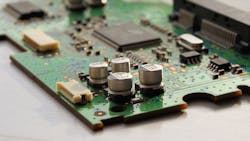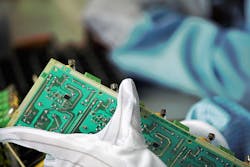Electronic Components: Why Reworkability Matters in Manufacturing
The pressure to become more environmentally conscious and more sustainable in operational terms is a major consideration for modern manufacturers. Often, it forms a key element of their corporate social responsibility (CSR) model. Consumer behavior is also driving the need for manufacturers to take sustainability seriously. A study carried out by YouGov for click and collect provider Doddle revealed that 43% of U.K. shoppers were more likely to shop with a rival retailer if they offered a greater range of sustainable delivery options.
The emergence of new environmental regulations is ramping up the pressure on manufacturers even further. The growth of legislation around chemicals usage is a case in point. Halogen-free manufacturing processes are becoming more important as new regulations come into play. The International Electrochemical Commission (IEC) ruling IEC 61249-2-21 has set the standard in this regard.
Moving forward, the use of water in the manufacturing environment may even be impacted. Deionized water is already essential for medical, electronics manufacturing, and food processing. With environmental issues unlikely to disappear from the legislative agenda, manufacturers need to prepare themselves for future regulation.
Dealing with E-Waste
One challenge that’s garnering more attention among manufacturers is finding ways to cut down on the electrical and electronic waste (e-waste) generated as a result of their activities. The quantity of e-waste created across the globe is rapidly escalating: Worldwide, the total volume is expected to reach round 7 kilograms of e-waste per capita by 2022.
At a manufacturing level, we’re seeing a greater focus on reducing this waste. One way to achieve that reduction is by ensuring that components of end products and new technological solutions introduced across the supply chain are fully reworkable and can be readily repaired.
It’s important to highlight that while they’re often used interchangeably, reworkability and repairability are actually two different things. Reworkability typically relates to a component like a printed circuit board (PCB), but often will also involve full electronic devices. It generally refers to the process of replacing faulty or damaged components on the PCB at the manufacturing site, typically before it leaves the production environment.
The term “repairable” generally means the ability to be fixed post sale outside the manufacturing environment. In the context of the manufacturing process, though, it’s increasingly important that each individual product is both easy to rework and easy to repair.
Scoping the Challenge
It’s becoming more important than ever that manufacturers can rework and re-solder components where problems occur, rather than having to scrap and throw away devices every time a part fails. With new “right to repair” legislation coming on-stream across the world, reworkability and its role in reducing wastage and extending product life is set to become an even more critical requirement across manufacturing in the future.
We’ve seen a drive by groups and individuals to make repairs of consumer products easier and more cost-effective. The EU commission recently ratified new “right to repair” regulations that will take hold in 2021. The legislation change will force manufacturers to make spare parts easily accessible, along with any software or manuals needed to complete the repairs. Not only will this affect the monopolies that manufacturers currently have on after-sale repair work, it will also mean that, freed from the threat of voiding warranties, more consumers will take matters into their own hands and attempt repairs at home.
The easier it is to take apart a device without causing damage, the easier a device is to fix. Recent design trends in miniaturization and physical water protection mean that electronics are often impossible to open without compromising the device’s water resistance or even the structural integrity of the device. This is due to the presence of rigid gaskets and seals, as well as thick conformal coatings or glues, which physically impede the ingress of water but are vulnerable to mechanical damage. As repairability gains in importance, these mechanical solutions become more unfit for purpose.
Even if a device can be safely taken apart for repairs, the application of thick conformal coatings to components and circuit boards can make rework or repair impossible by covering connectors and preventing the re-soldering of components. And if a rework is technically possible, in these cases, it’s unlikely to be cost-effective, and in practical terms the faulty product is likely to end up as e-waste.
Putting aside consumer preferences and an increasingly demanding legislative landscape, manufacturers are also placing greater emphasis on reworkability because it helps reduce waste in the manufacturing process and makes the product more sustainable. This helps manufacturers save money on materials and scrappage costs and ultimately achieve better profitability across their product lines.
Reaping the Rewards
Facing these challenges, how can manufacturers continue to offer products with high levels of water-resistance while reaping the benefits of consumer goodwill and cost-effective production practices? The use of modern nano-coating technology allows manufacturers to produce devices with levels of water resistance as good as or better than traditional solutions, while retaining full reworkability.
Nano coatings protect PCBs and even whole devices from the inside out and eliminate the need for bulky mechanical seals that might make a device difficult or unsafe to open. Unlike old-fashioned conformal coatings, nano coatings are so fine that circuit boards remain accessible and fully reworkable. The growing use of nano-coating technology by the electronics industry is just one example of how high-tech solutions can keep manufacturers competitive in a market where sustainability is rising up the business agenda and both consumers and legislators begin to prioritize environmental concerns.
Simon Vogt is Chief Commercial Officer at P2i.
About the Author
Simon Vogt
Chief Commercial Officer, P2i
Simon Vogt has over 20 years telecommunications experience at Motorola, Nokia, Siemens Networks, and NewNet Communication Technologies, managing the proposals and pricing operations. Having joined P2i in July 2017 as Group Head of Sales Operations, his role has since expanded to take on responsibility for Sales, Business Development and Pricing. Simon earned a Master’s degree in Information Technology and has a multinational background, having lived and worked in the U.K., Dubai, and the U.S.

